The marina is to the west of a large boat-yard and the S.S. Great Britain, on the southern side of the harbour. They have built a lot of houses here in recent years, and there are frequent water buses and ferries to the town centre and beyond. This end of the harbour also sees a lot of water sport activity, and there were dragon boat races between the marina and the seaward end of the harbour.
We were anxious, as one always is on trips like this, that we might not be able to park somewhere quiet enough to get the boat off yet near enough to the water for us to launch. Bristol Marina proved outstanding in this respect. There is a double slipway with ample floating jetty space for mooring along side after launch, and a barrier-controlled car-park for slipway users. This was all included in the £7.50 launch fee which includes the necessary day licence to use the harbour. This probably compares favorably with a long stay car park in the city centre!
We bought our licence from a very helpful lady at the marina office and found a quiet corner of the car park to unload and assemble the boat. We were on the water 30 minutes after arriving.
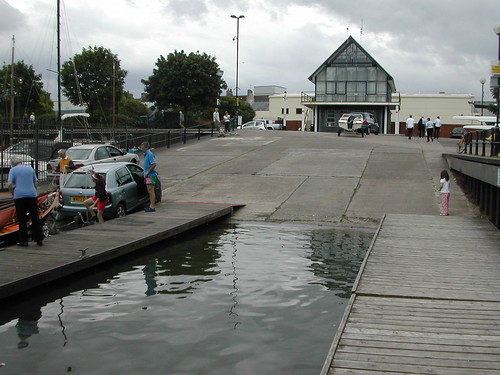
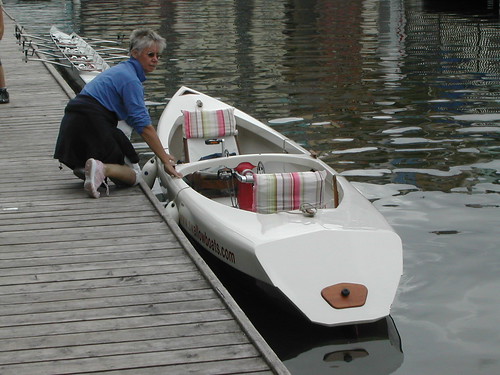
Bristol has a "floating" harbour held at high tide level, so boats float all the time. The tide rises up the river to a point where you can get out to sea for only a relatively short period each tide, but quite large boats can still make it right up to the centre of Bristol. Historically, the city was built around its harbour and it is still a focal point even though Bristol has not been a major commercial port for more than 100 years. Unlike Cardiff, a major commercial port in more recent times, Bristol still "faces" its harbour. As you proceed out of Bristol city centre up the river you can still find "backside" water frontage, but even this is slowly being converted to, or replaced by, homes and offices that face the water. This is good news for Winsome, and for residents and office workers in central Bristol.
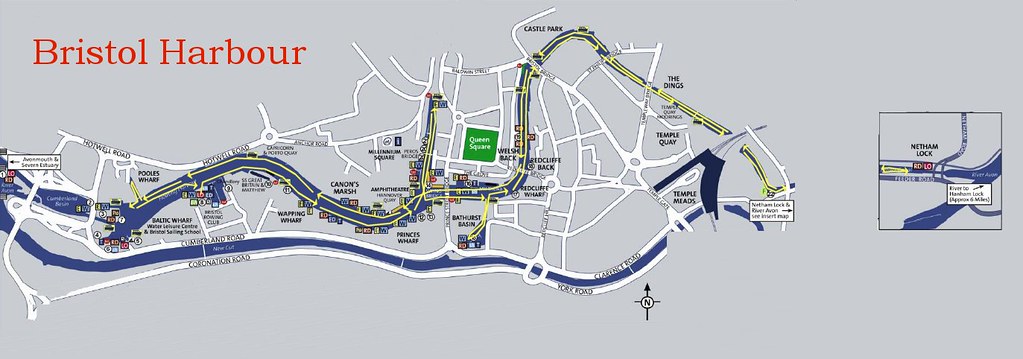
Also good news in terms of exposure are the large numbers of visitors. Bristol Harbour is a tourist destination with waterborne activities and waterside attractions such as museums and art galleries and the @Bristol exploratory, the S.S. Great Britain and the replica of Cabot's Matthew, theatres, cinemas, cafes, restaurants, pubs and shops. There is ample mooring in the city centre for visiting craft, and there is clearly a substantial resident population living on boats moored in the harbour. And these boats are not, in the main, "posh" - some are quite old and battered, but even the new ones can be interesting.
Because of the dragon boat races, we decided to head "upstream" to the town centre to see what we could find. Looking at the map, we didn't expect this to take very long, but it did. There were two reasons for this: firstly, there is a great deal to see, and secondly the harbour, the river and its feeder canal are much larger and longer than we thought.
We noticed at the outset that we were going much more slowly than we usually do. Rural cruising offers more spectacular scenery, but it changes slowly, so there can be long stretches where there isn't much new to see. In Bristol Harbour, there is something new to see every few yards, and the best place to see it is from the water. We're not very conscientious photographers (you may have already noticed that) but we took more photographs in a couple of hours in Bristol Harbour than we normally would in a month. You'll be pleased to learn that most of them suffered from the poor light and poorer technique, but the fact that we are resolved to get a more up-to-date camera as a result of this trip says a lot.
There are ferries and trip boats plying up and down the harbour, and we noted that some of the newer water-facing offices have jetties to supplement the frequent public water bus-stops. You can well imagine Bristol residents commuting to work at a waterside office in the city centre from one of the residential developments at the western end of the harbour or even, perhaps, from house along the Avon to the east of the city. We haven't seen what the place is like after dark, though, so perhaps getting home from the pub or restaurant after work is more difficult.
Just east of the marina slipway is the marina itself which has extensive moorings for boats that can in principle make it out to sea. We wondered how many of them ever do. In Cardiff Bay, the commodore of one of the yacht clubs reckoned only about 30% of his members ever went through the barrage locks, but Cardiff Bay does provide some sailing area. We guessed that sea trips would probably not be very frequent, if only because it would take a while to get to Avonmouth anyway, and we doubt you'd be able to make a day trip of it.
The next major attraction upstream is the S.S. Great Britain centre - the huge 6 masted ship has its own dry dock and a substantial visitor centre. It was a backup destination for us if the weather broke, but it didn't. All we have are photographs.

Beyond the Great Britain on the south side of the harbour are what remains of the working port. There are railway tracks and cranes, but there are also ice-cream stands, a couple of cafes, some loos (with a jetty) and an industrial museum. The high harbour walls give you some idea of the size of boat that was formerly serviced here, and there are some sizeable residential boats. A small boat like Winsome can only land at a few places where there are steps down the water or where there is a jetty. On the north side there is a lot more office and premium residential building, but the same high quaysides predominate. There are, however, some pretty spectacular houseboats moored on the north side. A couple of these were based on what had been fairly sea-going hulls, but I doubt they would now survive anywhere other than secured to a dockside in the floating harbour.


Even in the city centre, the quaysides are "ship" height, but there are now more floating jetties, some of them accessible to visiting boats like ours, other private moorings protected by security gates. We cruised up past the Watershed building to where the original harbour has now been filled in. We'd never seen the cascading water feature from the water before.
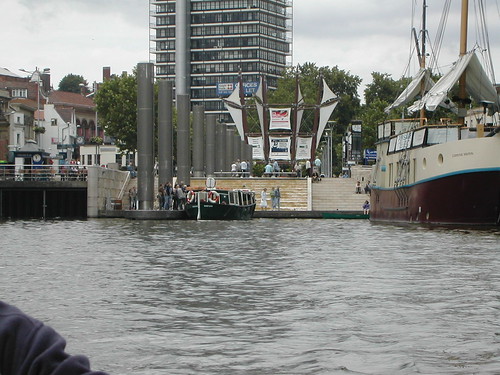
This water cul-de-sac is bounded on all sides by eating and drinking places, as well as arts centres like the Arnolfini. We executed a controlled u-turn to the evident delight of the crowd, and returned to the main drag. Turning left under the swing bridge we now proceeded further up the river past floating restaurants and shops.
We made a short detour down to Bathhurst Basin, which must once upon a time have provided another exit point from the floating harbour to the river Avon beyond, but now offers a rather fine marina and residents' moorings for the housing that encircles it.
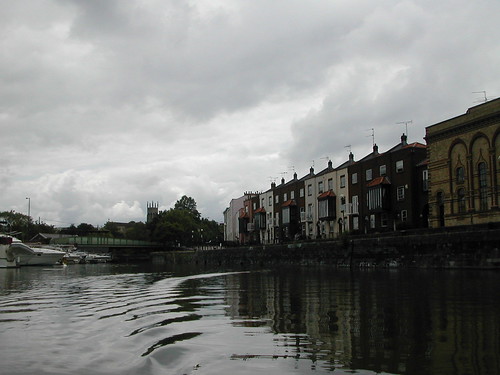
Emerging from the basin we turned right to pass under Bristol bridge and pass the old castle park. This would be a good place to stop if you were on a shopping expedition, being the nearest point to the main shopping centre. Above the castle park, the river is closed in on all sides by former dockside warehouses with no obvious quayside where goods were presumably hoisted directly into the buildings. Some of these buildings are now derelict, but others have been or are in the process of being converted to apartment blocks or new offices. There are also some completely new buildings which take more advantage of their waterside location. Whereas the old industrial buildings often present a blank wall to the water, the newly-built ones are clearly making the water an attractive feature. With luck, this will generate demand to make the waterway itself more attractive. In these upper reaches of the harbour there are still a large number of houseboats, but more of these were now conventional canal narrowboats rather than boats that might once have gone to sea.
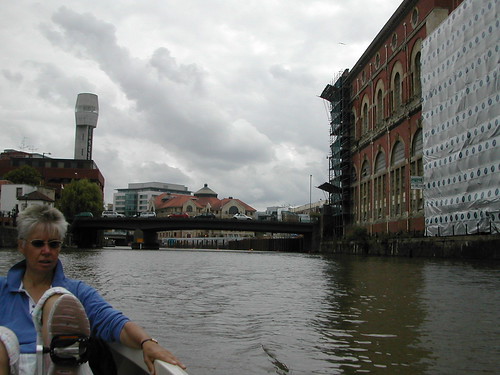
Bristol is several miles from the mouth of the river Avon, at its (original) lowest crossing point. The river is tidal well inland of the city, but the rise and fall of the tide in the Severn estuary probably made Bristol even in its heyday quite hard work as a port. You'd probably need help coming up the river on the tide, and you'd dry out between that tide and the one on which you left, but the port would at least have been sheltered with decent road access to the midlands. The floating harbour was built around the turn of the 19th century, and required diverting the river to the south of its original course, and putting a couple of big locks on the original channel which opened only at high tide. Netham weir on the Avon to the east of the city maintains the water level in the floating harbour. It also marks the start of the Avon navigation up to Bath from where you can take the Kennet and Avon canal through to Reading and the Thames. Bristol is therefore a canal terminus as well as a sea port, which is presumably why there are so many narrowboats.
As you cruise up the floating harbour into the eastern side of the city, and under the railway bridges at Temple Meads station you are abruptly diverted left onto an artificial "feeder" canal that re-joins the river Avon at Netham. We had already decided to turn round at this point, rather than go through the lock, but when we got there were puzzled to see that the lock was open, and showed no change in level to the river beyond. So it would have been easy to go through and travel the further 4 miles up to the first "proper" lock on the Avon navigation at Hanham. We later learned that Netham lock only closes when particularly high tides on the Avon rise above the level of the weir. In other words, Netham lock and its accompanying weir are designed to preserve the water level in the floating harbour. I guess the sea locks at the Western end of the floating harbour also have to be kept shut at the top of spring high tides for the same reason.
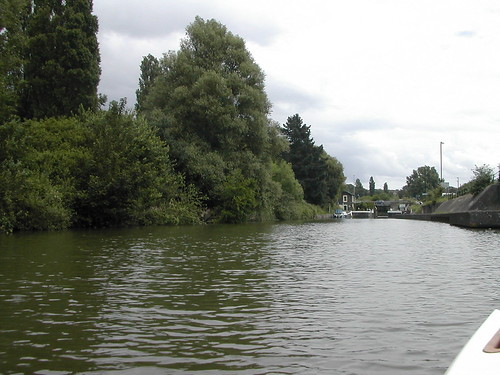
So we turned round and retraced our wake back to the city centre for a cup of tea and a bun at the Arnolfini before returning down to the seaward end to observe the dragon boat racing at closer quarters. Here we spotted and explored a fine residential development at Pooles Wharf which appeared to have residents' moorings and a rather fine dutch barge.


It was now nearing 4pm and although the marina offices close at 4, we had been issued with the keycode number to exit the car park. However, just to be on the safe side, we decided to call it a day and proceeded to the slipway to haul the boat out. This was fairly straightforward, although the slipway is somewhat steeper than any we have used before. It's possible we might have been able to recover Winsome directly onto her dolly, but we used the boat roller just in case. We rolled her back to the car park, stripped her down, and were on our way by shortly after 4.
All in all, a great day out and we would have set off earlier had we realised the weather would hold and that access to the river above Netham would be free. We'll do that next time. A final note that struck both of us was how friendly everyone was at Bristol. The marina office couldn't have been more helpful. The harbour master was very welcoming and the numerous ferry and trip boat skippers who passed us all smiled and waved as they went by. The rowing club safety boats supervising the dragon boats were very engaged and engaging, and we had pretty positive interchanges with everyone we met. It must be something in the water.
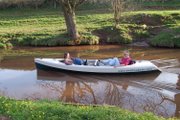
No comments:
Post a Comment